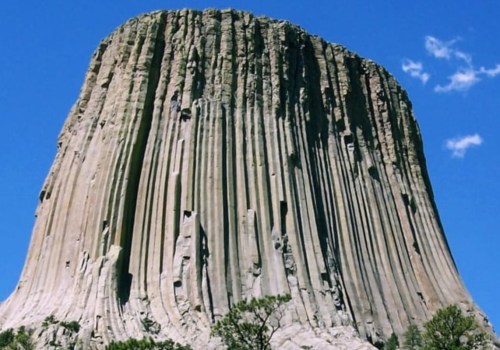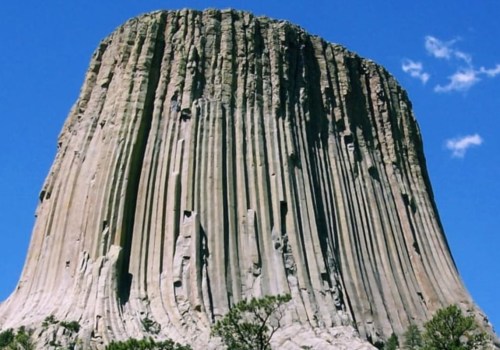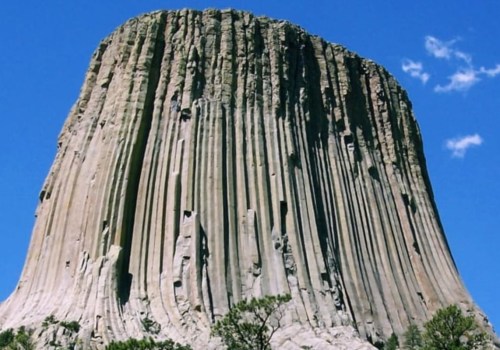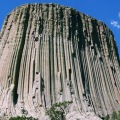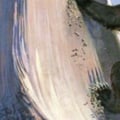Devils Tower is an almost vertical monolith in northeastern Wyoming, near the Belle Fourche River, surrounded by Ponderosa pines. It is 867 feet (264 meters) tall measured from its base and 1,267 feet (386 meters) measured from the river valley; its summit has an elevation of 5,112 feet (1558 meters) above sea level. The summit appears flat from the ground, although it has a slight dome shape. Squirrels, birds, mice, rats, and sometimes snakes can be found on the top, which covers approximately 1.5 acres, approximately 200 feet by 400 feet, approximately the size of a football field.
Somewhat rocky, native grasses, cacti, moss and mugwort grow. The striated sides are covered with lichen in places. There is also a sizeable prairie dog town near the base, whose circumference is one mile. There is a trail around it, which covers 1.3 miles.
Devils Tower was the first national monument designated by the United States, established on September 24, 1906 by President Theodore Roosevelt. The area of the Monument covers 2.1 square miles (5.4 km2). There is a myriad of plant and animal life around the monolith. Native Americans consider the area sacred, a place of prayer and renewal.
The name Devils Tower probably originated in 1875, during an expedition led by Col. Richard Irving Dodge when his interpreter misinterpreted the name to refer to the Tower of the Bad God. Later, it was shortened to Devils Tower. All signs and information references use the name Devils Tower, following geographical naming standards in which the apostrophe is removed.
Legends tell of six Sioux girls who picked flowers when they were chased by bears. Feeling sorry for them, the Great Spirit lifted the ground under the girls. The bears tried to climb the rock, but they fell, leaving their scratch marks on the sides. Devils Tower is a sacred site in the eyes of several tribes of the Native American Plains, including the Lakota Sioux, Cheyenne and Kiowa. Because of this sacred belief, many Indian leaders opposed the growing practice of rock climbers climbing the Monument, desecrating a sacred site.
The climbers, on the other hand, believed that climbing the Tower was their right, since it is on federal lands. A compromise was reached in 1995, with a voluntary ban on climbing during the month of June, when tribes hold ceremonies around the monument. Climbers are asked, but not mandatory, to stay outside the Tower during that month. According to the PBS documentary In Light of Reverence, in the first year of the ban, approximately 85 percent of climbers respect it and voluntarily choose to refrain from climbing in June. However, several climbers, along with the Mountain States Legal Foundation, sued the Park Service, alleging an inappropriate government entanglement with religion. Most of the landscape surrounding Devils Tower is made up of sedimentary rocks.
The oldest rocks visible in the Devils Tower National Monument were deposited in a shallow sea during the Triassic period, 225 to 195 million years ago. This dark red sandstone and maroon silt interspersed with shale can be seen along the Belle Fourche River. Oxidation of iron ores causes reddening of rocks. This layer of rock is known as the Spearfish Formation. Above this layer is a thin band of white gypsum called Spring Formation Gypsum which was deposited during Jurassic period 195 to 136 million years ago.
Created as sea levels and climates changed repeatedly greyish-green shales (deposited in low-oxygen environments such as swamps) were interspersed with fine-grained sandstones limestones and sometimes thin beds of red earthenware. This composition called Stockade Beaver member is part of Sundance lineup while Hulett Sandstone member which is also part of Sundance Formation is composed of fine-grained yellow sandstone weatherproof it forms almost vertical cliffs that surround Tower itself. Geologists agree that Devils Tower was formed by intrusion of igneous material but what they can't agree on is how exactly that process was carried out. Geologists Carpenter and Russell studied Devils Tower in late 19th century and concluded that Tower consisted of an igneous intrusion later geologists sought further explanations. Several geologists believe that molten rock that comprises Tower may not have surfaced while other researchers are convinced that tower is all that remains of what was once large explosive volcano. In 1907 scientists Darton and O'Hara decided that Devils Tower should be an eroded remnant of laccolit - large mass of igneous rock that is introduced through sedimentary rock beds but does not actually reach surface producing rounded bulge in upper sedimentary layers. This theory was quite popular in early 20th century as numerous studies had previously been conducted on various laccolites in southwestern United States while other theories have suggested that Devil's Tower is volcanic plug or neck of extinct volcano. Presumably if Devil's Tower were volcanic plug any volcanic created by it volcanic ash lava flows volcanic debris would have eroded long ago some pyroclastic materials same age as Devils Tower have been identified elsewhere in Wyoming. Geologists agree that igneous material was introduced and then cooled as phonolite porphyry light to dark gray or greenish gray igneous trachytic rock with conspicuous white feldspar crystals as lava cooled hexagonal (and sometimes 4- 5- and 7-sided) columns formed as rock continued to cool vertical columns contracted horizontally in volume and cracks began to appear at 120 degree angles generally forming compact 6-sided columns.

